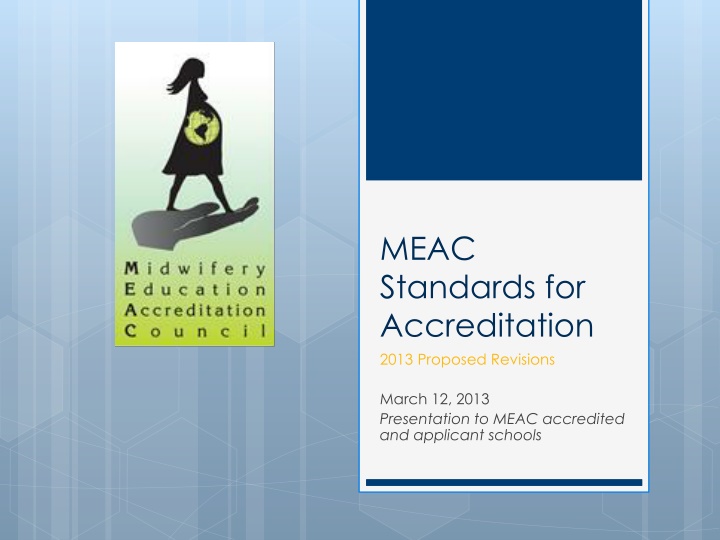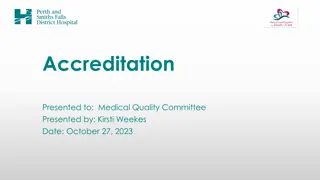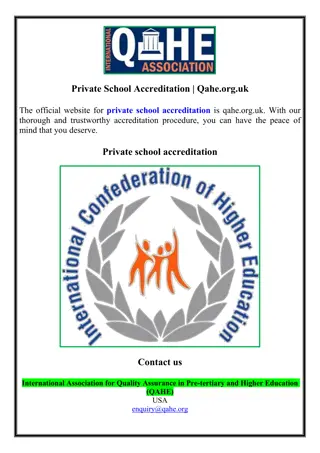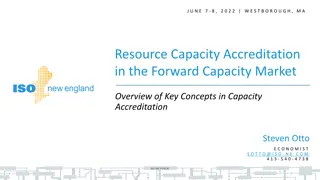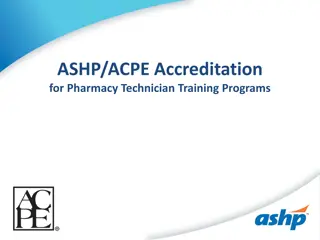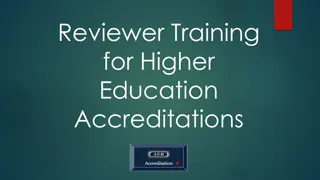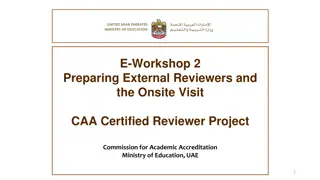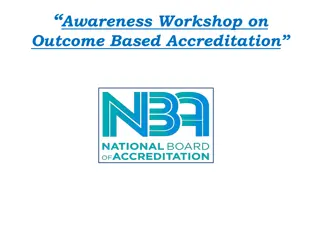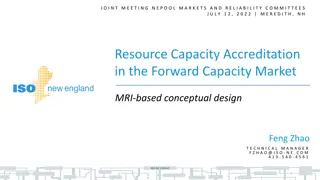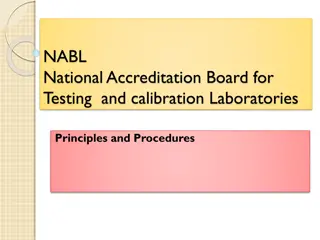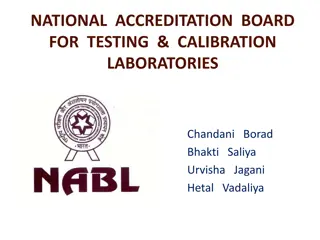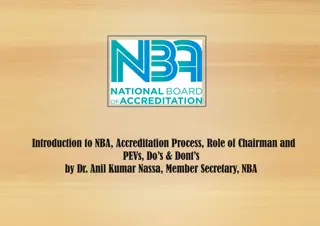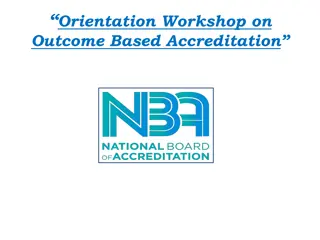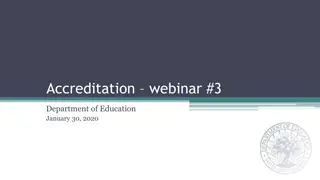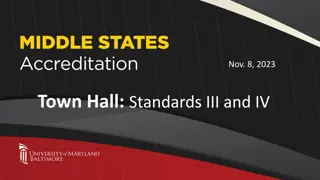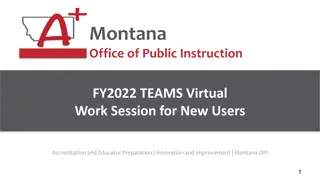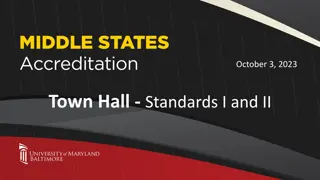MEAC Accreditation Standards 2013
MEAC accreditation ensures quality in midwifery education, establishes standards, and facilitates federal student loans. Learn about the process, goals, and maintenance of recognition by USDE.
Download Presentation

Please find below an Image/Link to download the presentation.
The content on the website is provided AS IS for your information and personal use only. It may not be sold, licensed, or shared on other websites without obtaining consent from the author.If you encounter any issues during the download, it is possible that the publisher has removed the file from their server.
You are allowed to download the files provided on this website for personal or commercial use, subject to the condition that they are used lawfully. All files are the property of their respective owners.
The content on the website is provided AS IS for your information and personal use only. It may not be sold, licensed, or shared on other websites without obtaining consent from the author.
E N D
Presentation Transcript
MEAC Standards for Accreditation 2013 Proposed Revisions March 12, 2013 Presentation to MEAC accredited and applicant schools
What is accreditation? A voluntary, peer-review process designed both to assure minimum standards and to help institutions and/or programs assess and improve themselves Institutions and/or programs that request MEAC s evaluation and that meet our standards are then "accredited" by MEAC for a period no longer than five years.
What are the goals of accreditation? Ensure students that education provided by institutions and/or programs meet acceptable levels of quality Continual quality improvement Institutions that are accredited by MEAC may disperse federal student loans
What does MEAC do? Establish basic minimum quality standards for the education of midwives Determine the extent to which standards are met through peer review process Publicly announce findings
United States Department of Education (USDE) MEAC is recognized by the USDE as an Institutional and Programmatic Accreditor This recognition empowers MEAC to be a gatekeeper for Title IV funds (federal student loans) MEAC is bound by the federal regulations which govern higher education in the United States
MEACs scope of recognition includes: free-standing institutions and midwifery programs that reside within institutions accredited by other agencies certificate or degree-granting programs institutions and programs that offer distance education courses
How does MEAC maintain its recognition by the USDE? Process very similar to the one schools go through to become accredited MEAC will submit a petition for continued recognition again in 2015 Petition is reviewed by USDE staff, NACIQI and ultimately the U.S. Secretary of Education Except they re not our peers!
What does the USDE monitor? Criteria for Recognition A few examples of criteria include: Administration, Fiscal and Governance Link to federal programs (Title IV) Acceptance of Agency by Others Policies and Procedures (including how we review our standards for accreditation) How we do our work as accreditors Consistency in decision making
MEACs Standards Some basic terms Standards The overarching goal or category Benchmarks Concrete step towards meeting a standard Demonstrations the actual documentation required to demonstrate that a benchmark has been met; often there will be multiple demonstrations for one benchmark
Example Standard VI: Student Services Benchmark VI-B1: If the institution has a distance learning component, students have access to appropriate technical assistance and technical support staff throughout the duration of the program and student support personnel are available to address student questions, problems, bug reporting, and complaints. Demonstration VI-B1-demo 1: Describe how students in your distance courses can access technical support throughout the program.
2013 proposed revisions fall into two categories: 1. Overall Changes Format and presentation 2. Specific Content Changes Clarification or simplification Closer alignment with national higher education and international midwifery education resources; informed by multiple sources
Sources that informed MEACs proposed revisions
Sources that informed MEACs proposed revisions International Confederation of Midwives (ICM) Global Standards for Midwifery Education (2010) Essential Competencies for Basic Midwifery Practice (2010)
ICM Global Standards for Midwifery Education Significant proposed changes include: Increased requirements for student assessment Increased requirements for faculty training Requirement that schools create the opportunity for course and clinical faculty to work cooperatively Increased oversight and evaluation of clinical faculty and clinical sites Increased requirements for qualifications of the head of the midwifery program
ICM Essential Competencies for Basic Midwifery Practice In 2010, the ICM announced a set of competencies considered core or basic MEAC-accredited schools have an opportunity to bring expected competencies into alignment with what midwives are learning globally Development of a new MEAC Curriculum Checklist of Essential Competencies which encompasses the NARM list, the MANA Core Competencies as well as the ICM competencies.
Sources that informed MEACs proposed revisions The Sloan Consortium Organization dedicated to integrating online education into the mainstream of higher education Help institutions and individual educators improve the quality and scale of online education. 2011 Scorecard for measuring and quantifying quality within distance education programs. MEAC carefully reviewed the recommended standards and integrated them throughout the ten standards, where appropriate.
Sloan Consortium: benchmarks for success in distance education Significant proposed changes include: Additional requirements for faculty and student training and support in use of technology Availability of technical support resources Higher level of security and system backup protection required to assure integrity and reliability
Sources that informed MEACs proposed revisions The United States Department of Education The vast majority of MEAC s standards and benchmarks are unchanged from the 2007 version in keeping with requirements outlined by the postsecondary education regulations of the U.S. Department of Education.
USDE Regulations Significant proposed changes include: State authorization of distance education and clinical training sites Verification of student identity in distance learning programs Expectations around student achievement and credit hours
Sources that informed MEACs proposed revisions Commitment to diversity and cultural versatility in midwifery education A thorough review of MEAC standards was conducted to look for ways that MEAC- accredited schools could strengthen its commitment to diversity and cultural versatility.
Diversity and cultural versatility Significant proposed changes include: non-discrimination language for admissions, faculty and administrative hiring training in cultural versatility for students and faculty increased library resources enhanced student support services to assist with the retention of a diverse student body.
Sources that informed MEACs proposed revisions Commitment to Competency-Based Midwifery Education MEAC values competency-based educational programs that train midwives to serve culturally, socially, and economically diverse women and families inclusive of sex, gender identity, race, marital status, ethnicity, religion, age, sexual orientation, and disability.
Competency Based Education MEAC believes the following to be integral to the philosophy of competency based education: Mastery of core competencies is not defined by the length of time spent in the educational process but should meet an international standard of midwifery education. Mastery of core competencies can be accomplished through various educational routes including conventional classroom format, distance learning, and clinical placement.
Competency-Based Education Significant proposed changes include: Learning activities and student assessment support competency-based education. Achievement of essential competencies is the goal of the learning activities and the measure of student success. Standards allows programs to design their own timeframes and provide a rationale for how this timeframe was determined appropriate.
Note regarding NARMs 2-year clinical requirement Standard 2 A4: The sequence and content of the curriculum enable the student to acquire the clinical experience required for national certification by the North American Registry of Midwives (NARM), such as number and type of clinical experiences, requirements regarding continuity of care and birth settings, second signature on specified skills and timeframes for clinical training.
So, you want to see the big picture? Proposed Standards for Institutional Accreditation: https://www.dropbox.com/sh/upogczs1q57rj0o/bZ7YL3syQK Proposed Standards for Programmatic Accreditation: https://www.dropbox.com/sh/kcypyt41ql8o38k/LGOFoh0DnR
Standards Implementation Timeline Date June 3, 2013 Activity MEAC Board vote to adopt 2013 Standards for Programmatic and Institutional Accreditation Effective date of revised 2013 Standards for Programmatic and Institutional Accreditation for all new and accredited programs. After this date, all initial applications and reaccreditation applications will be held to the new standards. September 1, 2013 June, 2014 All new applicants and accredited programs must begin working toward compliance by constructing an implementation plan. This plan should be submitted with annual report due to MEAC in June, 2014. All MEAC accredited schools will be in full compliance with the 2013 Standards for Programmatic and Institutional Accreditation. Schools will either attest to compliance with the new standards through their annual report or they will demonstrate compliance during a regular accreditation review, whichever occurs first. All MEAC accredited schools will be required to provide updates to their compliance status with the submission of annual reports. June 1, 2015 Annual Reports after 2016 and beyond
Stakeholder Feedback is integral to this process Please share your thoughts and ideas with MEAC! www.surveymonkey.com/s/meacstandards
Questions? We have a few minutes for questions
Thank you Your participation in today s webinar is vital to the work of improving midwifery education!
